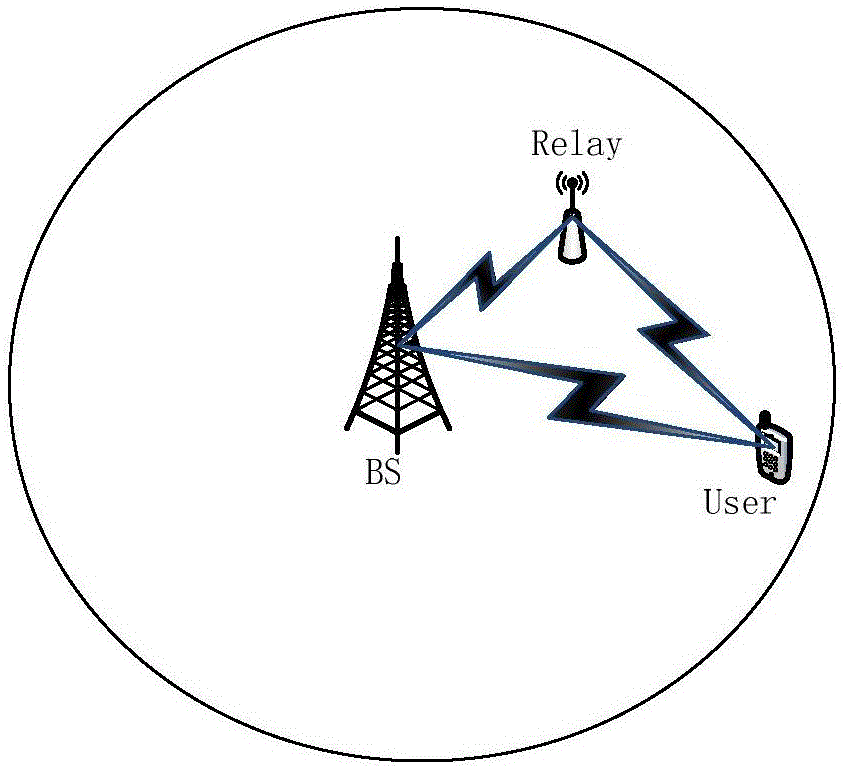Energy acquisition relay station-based heterogeneous cellular network power allocation method
A technology of energy harvesting and cellular network, which is applied in network planning, energy consumption reduction, advanced technology, etc.
- Summary
- Abstract
- Description
- Claims
- Application Information
AI Technical Summary
Problems solved by technology
Method used
Image
Examples
Embodiment 1
[0105] A method for assigning power in a heterogeneous cellular network based on an energy harvesting relay station, comprising the following steps:
[0106]Step 1: System scenario analysis, the problem comes down to:
[0107] The present invention considers a classic three-node scenario in a heterogeneous cellular network based on an energy harvesting relay station. For a special application scenario, the source is practical application, and the scenario setting is detailed and reasonable, and has practical guiding significance. In the scene, there is an energy harvesting base station BS (abbreviated as B), an energy harvesting relay station Relay (abbreviated as R) and a target communication cellular user User (abbreviated as U), considering the energy harvesting base station B and the cellular user There is a direct path between U, which can be cooperatively forwarded through the relay station R. The relay station R adopts the decoding and forwarding (Decode Forward, abbrev...
Embodiment 2
[0164] + On the basis of the first embodiment, we further improve it by adding consideration of the resource allocation problem under the time delay constraint. The invention considers the problem of optimal system performance under the condition of time delay limitation, achieves a compromise between time delay and network rate, and ensures that cellular users meet the best network performance under the time delay limit required by services. Specifically, step 5 mentioned above also includes:
[0165] comparative judgment If yes, skip to step 6, and if not, skip to step A. After skipping to step A, the algorithm will not end, and further in-depth optimization will solve the optimization problem more accurately;
[0166] Step A: Calculate
[0167]
[0168]
[0169]
[0170]
[0171] Among them: i b,k means from i b,k-1 The power turning point of the first base station B in the future, Indicates the power allocation scheme of the corresponding base station B,...
Embodiment 3
[0191] On the basis of Embodiment 1 and Embodiment 2 of the present invention, we make further improvements. For solving the optimization problem, we adopt convex optimization processing to convert the objective function of the optimization problem, without approximate calculation, without affecting the accuracy of the problem and at the same time extremely The computational complexity is greatly reduced, and the delay caused by system overhead is reduced.
[0192] Specifically, the step 2 also includes: convex optimization processing, using the Lagrangian theorem and KKT conditions in the convex optimization theory, the optimization problem can be subjected to convex optimization processing, and the optimization problem can be transformed into:
[0193]
[0194] We further analyze the optimization problem P2:
[0195] The optimization objective function is to maximize
[0196] The optimization variable is P B (i) and P R (i+1),
[0197]
[0198] The constraints ar...
PUM
 Login to View More
Login to View More Abstract
Description
Claims
Application Information
 Login to View More
Login to View More - R&D
- Intellectual Property
- Life Sciences
- Materials
- Tech Scout
- Unparalleled Data Quality
- Higher Quality Content
- 60% Fewer Hallucinations
Browse by: Latest US Patents, China's latest patents, Technical Efficacy Thesaurus, Application Domain, Technology Topic, Popular Technical Reports.
© 2025 PatSnap. All rights reserved.Legal|Privacy policy|Modern Slavery Act Transparency Statement|Sitemap|About US| Contact US: help@patsnap.com



